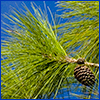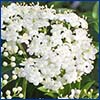The Neighborhood Gardener – October

Florida's Native Pines
 The pine family (Pinaceae) is a group of cone-bearing plants (conifers) known for its diversity and hardiness. Although most conifers are better adapted to cool climates, Florida does have seven species of native pines. In this article, we share some interesting facts about each of our native pine species and a handy trick for telling Florida's pines apart.
The pine family (Pinaceae) is a group of cone-bearing plants (conifers) known for its diversity and hardiness. Although most conifers are better adapted to cool climates, Florida does have seven species of native pines. In this article, we share some interesting facts about each of our native pine species and a handy trick for telling Florida's pines apart.
Garden Myths, Volume Two
 Every pursuit has its myths and legends; gardening is no different. From poisonous poinsettias to homemade pesticides, the tall tales passed along in gardening circles offer plenty of intrigue. This month we're excited to offer you volume two in our collection of garden myths. We'll also share the truth behind the fiction and some helpful resources. Read our myth-busting article.
Every pursuit has its myths and legends; gardening is no different. From poisonous poinsettias to homemade pesticides, the tall tales passed along in gardening circles offer plenty of intrigue. This month we're excited to offer you volume two in our collection of garden myths. We'll also share the truth behind the fiction and some helpful resources. Read our myth-busting article.
Sugarcane Mosiac Virus
 Recent reports of mosaic disease caused by Sugarcane Mosaic Virus (SCMV) give gardeners reason to be cautious. SCMV is named for its original host, sugarcane, but it affects turfgrasses throughout Florida. This article can help you recognize the signs and symptoms of SCMV and avoid infection in your landscape.
Recent reports of mosaic disease caused by Sugarcane Mosaic Virus (SCMV) give gardeners reason to be cautious. SCMV is named for its original host, sugarcane, but it affects turfgrasses throughout Florida. This article can help you recognize the signs and symptoms of SCMV and avoid infection in your landscape.
Wendy's Wanderings
 A while back I was presenting a butterfly gardening program and was asked, "How long do butterflies live?" I gave the standard response of 2-6 weeks, to which the person responded, "What about the monarch butterflies that migrate?" Yes indeed, what about the monarchs that migrate to Mexico to overwinter? I did some research and got the answer. Migrating monarch butterflies live up to eight months. This query opened the door for many other questions about monarchs and their migration and inspired me as well. Wendy shares what she learned and her own monarch experience in Mexico.
A while back I was presenting a butterfly gardening program and was asked, "How long do butterflies live?" I gave the standard response of 2-6 weeks, to which the person responded, "What about the monarch butterflies that migrate?" Yes indeed, what about the monarchs that migrate to Mexico to overwinter? I did some research and got the answer. Migrating monarch butterflies live up to eight months. This query opened the door for many other questions about monarchs and their migration and inspired me as well. Wendy shares what she learned and her own monarch experience in Mexico.
Plant of the Month: Elderberry
 Elderberry flowers and fruit have been prized around the world since prehistoric times. Pies, jellies, syrups, wines, spirits, teas, and dyes are just a few products you'll find packed with elderberry goodness. And of course the local wildlife enjoy this abundant food resource, too. Elderberry plants do contain toxins, however, and are sometimes mistaken for more toxic plants. Learn how to enjoy this native Florida fruit safely in this new article.
Elderberry flowers and fruit have been prized around the world since prehistoric times. Pies, jellies, syrups, wines, spirits, teas, and dyes are just a few products you'll find packed with elderberry goodness. And of course the local wildlife enjoy this abundant food resource, too. Elderberry plants do contain toxins, however, and are sometimes mistaken for more toxic plants. Learn how to enjoy this native Florida fruit safely in this new article.
MGV Book Club
 This autumn the Florida MGV Book Club is going back to school, and doing a little myth-busting, too! We're reading "How Plants Work" by Dr. Linda Chalker-Scott and exploring the plant physiology behind many of our gardening practices. Whether you're a veteran gardener or just starting out, you're invited to join us for this community reading. Learn more about the book and the MGV club.
This autumn the Florida MGV Book Club is going back to school, and doing a little myth-busting, too! We're reading "How Plants Work" by Dr. Linda Chalker-Scott and exploring the plant physiology behind many of our gardening practices. Whether you're a veteran gardener or just starting out, you're invited to join us for this community reading. Learn more about the book and the MGV club.
October in Your Garden
 October is a busy month in the Florida garden. There are plenty of edibles to plant, including strawberries. Even though temperatures are still warm, begin planting for the cooler months ahead. Dianthus, petunia, and pansy are good annuals for the fall garden. Planting bulbs like agapanthus and lilies now will bring spring and summer flowers.
October is a busy month in the Florida garden. There are plenty of edibles to plant, including strawberries. Even though temperatures are still warm, begin planting for the cooler months ahead. Dianthus, petunia, and pansy are good annuals for the fall garden. Planting bulbs like agapanthus and lilies now will bring spring and summer flowers.
For more month-by-month gardening tips, check out the Florida Gardening Calendar. Three different editions of the calendar provide specific tips for each of Florida's gardening regions—North, Central, and South.
What's Going On?
If your Master Gardener Volunteer program or Extension office is having an event, be sure to share it with us.

